
Nick MacKinnon is a freelance teacher of Maths, English and Medieval History, and lives above Haworth, in the last inhabited house before Top Withens = Wuthering Heights. In 1992 he founded the successful Campaign to Save Radio 4 Long Wave while in plaster following a rock-climbing accident on Skye. His poem ‘The metric system’ won the 2013 Forward Prize. His topical verse and satire appears in the Spectator, and his puzzles and problems in the Sunday Times and American Mathematical Monthly. Email: [email protected]
Guest blog – Walshaw Turbine 37 by Nick MacKinnon
Turbine 37: Stairs Edge SE 00464 33227 ///automatic.mushroom.flinch

This blog takes a first look at the implications of Ed Miliband’s 12 July 2024 letter overruling the Sunnica 50 MW solar farm outside Newmarket. The blog describes England’s relationship to the Kunming-Montreal framework on irreplaceable habitats signed at COP 15; and quotes KC opinion about the legal relationship of the Secretary of State to the Habitat Regulations.
7 November 2024 Francesca Grace is a student of anthropology at UCL and is writing a dissertation on community engagement with landscape. Since she also lives in Pecket Well, she wrote asking if we could go for a walk to a turbine site while she recorded our conversation. She has brought Walter, a dog her family look after. He is immaculately behaved and a beacon to other breeds.
Francesca was brought up here and the walk up the Old Haworth Road is one she has done on numerous wet Sunday afternoons. Colin, a farmer, stops in his pickup and we exchange campaign talk. I admit to Francesca that I am thrilled to be recognised. When I moved to West Yorkshire I was delighted at the interaction between people, twenty times better than Hampshire: it is a confident society. I must explain myself, of course, and after laying out what I consider the essence of my identity, light dawns on my interlocutor’s face and they say, “You’re Richard Sunderland’s brother-in-law!” To save time in future, Richard gave me a tee-shirt for my birthday with this information printed on it.
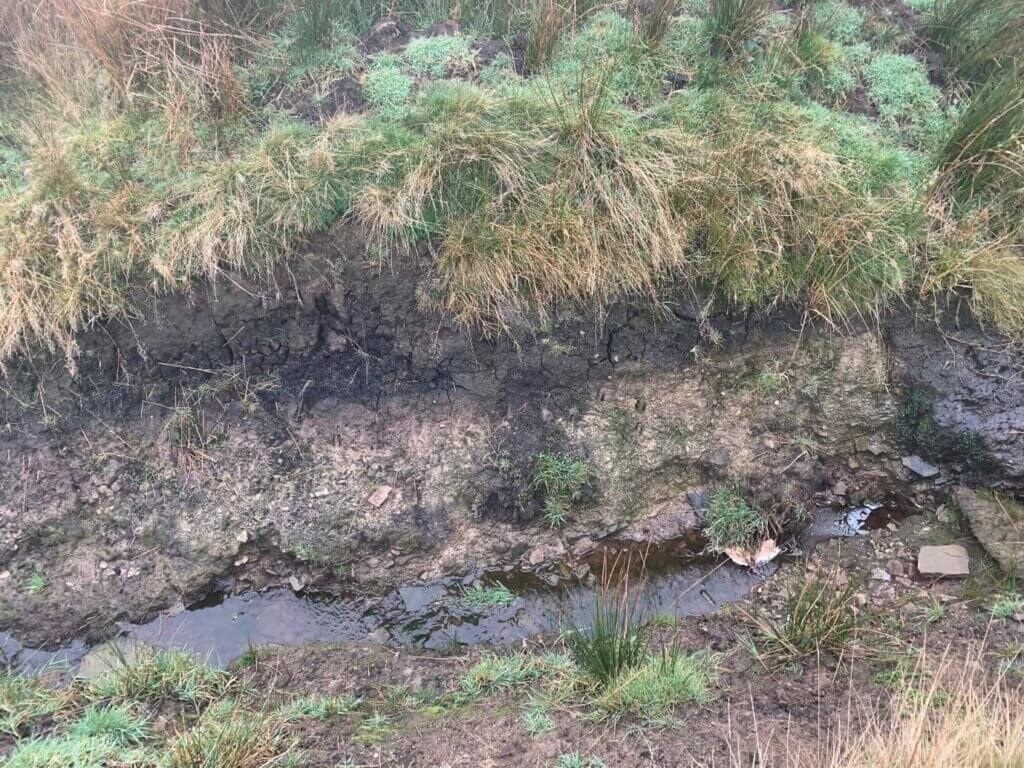
I have not listened to the four hour conversation that Francesca’s microphone effortlessly soaked up. The photograph above will give the measure of some of the scintillating play of wit. “See how the peat is drying out. It is only a few inches deep here. Below is boulder clay, what the road builders call competent geology.” I’m pretty sure there were disquisitions on the West Yorkshire Aggregate Assessments, on the competence of Richard Wilson and the user experience problems of the Electricity Northwest embedded capacity register. “It’s anthropology, Jim. but not as we know it.”
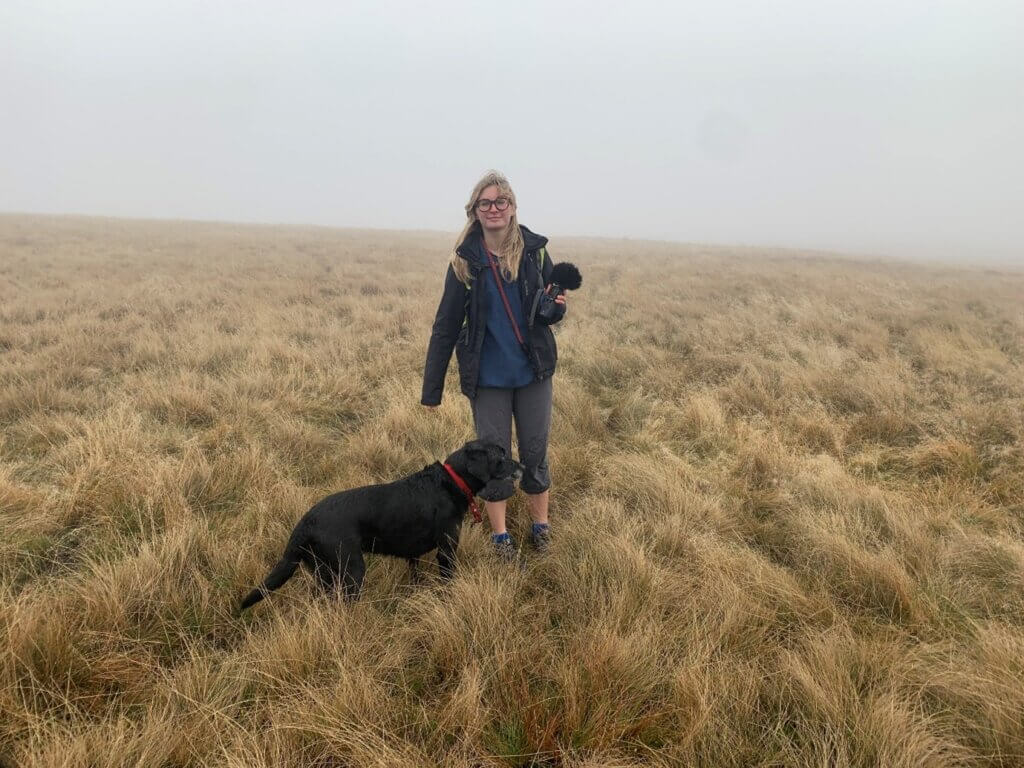
One of my father’s favourite books was Coming of Age in Samoa. My brother was a homebirth and after Dad had slopped the afterbirth into a hole in the garden, instead of a coconut, he dropped in a conker he had found on the day of conception. I shall never do anything so imaginative. Margaret Mead may not have been sufficiently objective about Samoan birth rituals, but Francesca retains a professional approach to the field work, especially as CWF really is in her back yard. After four hours I do not know whether she is for or against Calderdale Wind Farm.
We leave the Stairs track and take to the swamp along the contour to T37. We shake out the avalanche probe and …
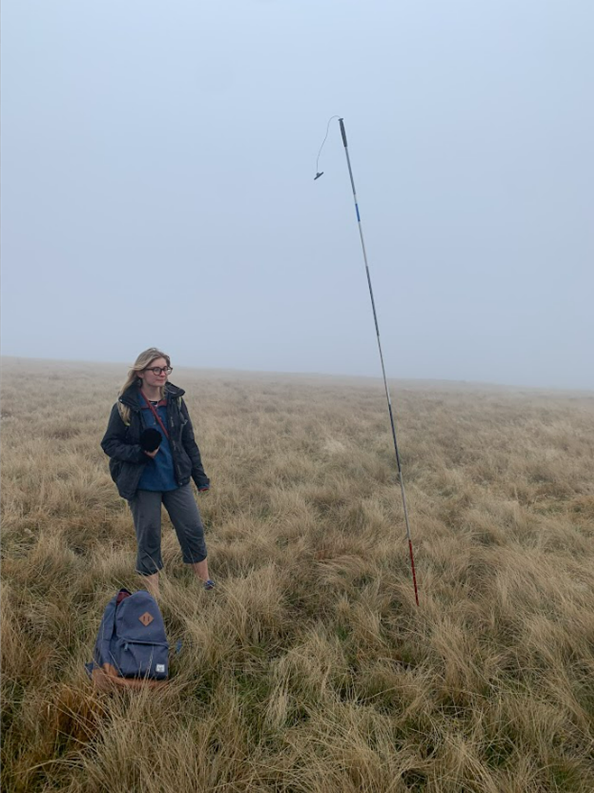
… Francesca retains admirable objectivity as the aluminium ritual spear stops at the boulder clay within five centimetres. We walk up to the boundary, and manage to find a metre or so. It is foggy and we can’t see the sweep of plateau that leads to Cock Hill Swamp. I hope the tape will reveal that at this point I offered a fresh hypothesis on the track system. We walk back along the top to Stairs and down to Pecket Well again. At the car I find myself hoarse: I haven’t spoken almost non-stop for four hours since my career-ending Hamlet. I hope the transcription is some use to Francesca. It was a lovely walk.
I went back when the fog cleared a couple of days later, along the conduit which I learned about from John Page. The grassy track is the perfect cross-country skiing approach to CWF, provided you can get up the zig-zags from Oxenhope in the fresh snow. The conduit shows that competent ground is available for serious infrastructure provided you pick the right contour
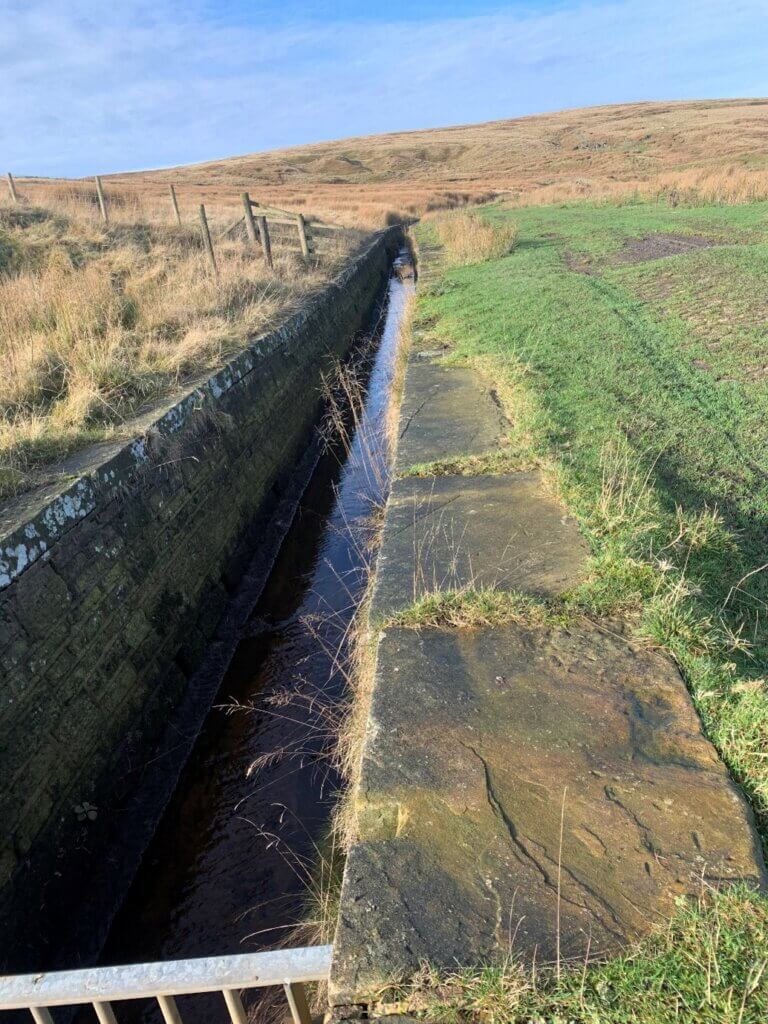
The dog and I stop on the outer edge of CWF’s neck. Through the gate is the high road and endless destruction of deep peat and imaginative heritage along the Brontë skyline.
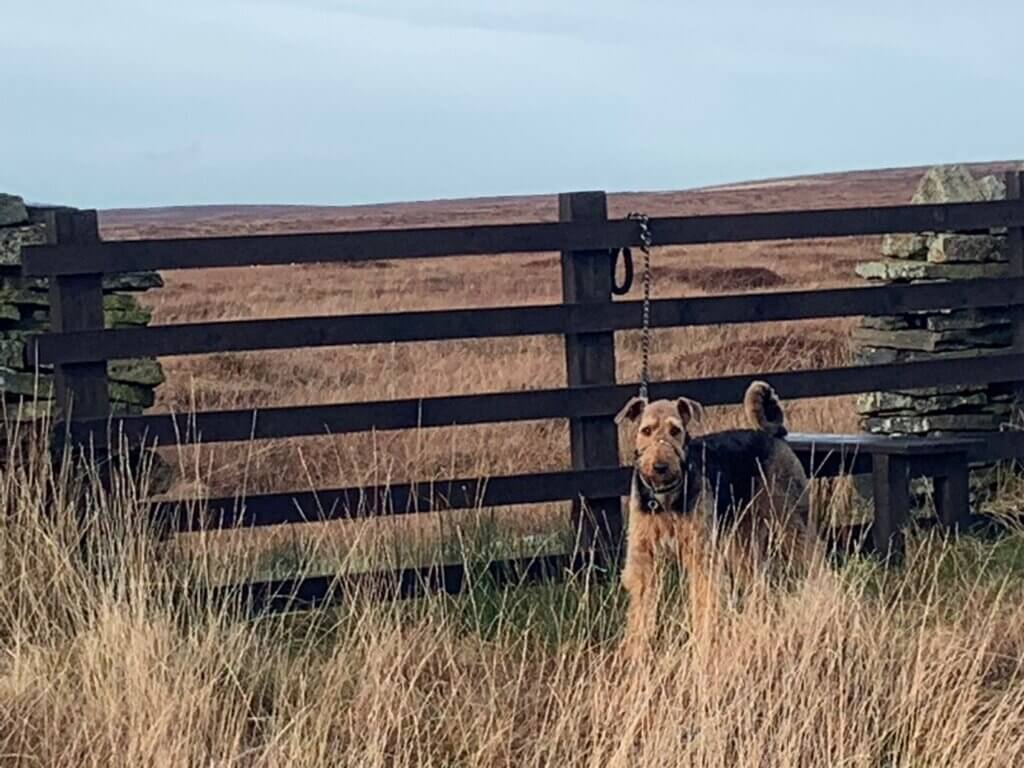
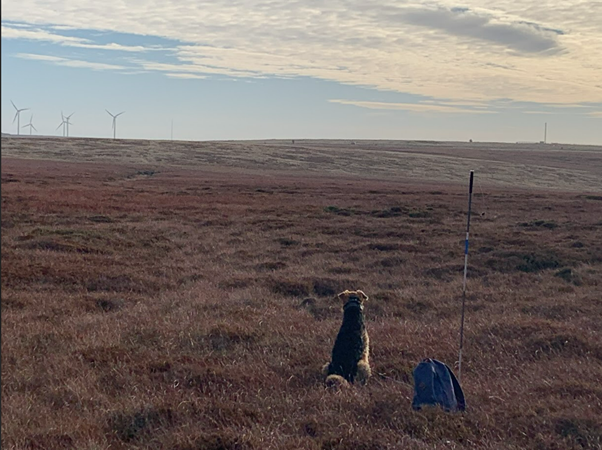
The view in the other direction is back to the site entrance by the Cock Hill mast on the right. The peat here is 150 cm deep. Ovenden Moor wind farm is just two km over Oxenhope Moor from Cock Hill. If sixty metre blades won’t come through Hebden Bridge or Oxenhope they will come on a short new track from OMWF. Perhaps they can fix the broken turbine (second from right) while they are at it. It has been dead for almost two years and is a standing indictment of renewable energy financing.
Although the full 302 MW CWF of the scoping report will destroy a vast amount of irreplaceable peat habitat, an illegal 170 MW wind farm can involve less peat loss. If we walk a minute down the hill on the Stairs track to the inner edge of CWF, we have the same view but almost no peat.
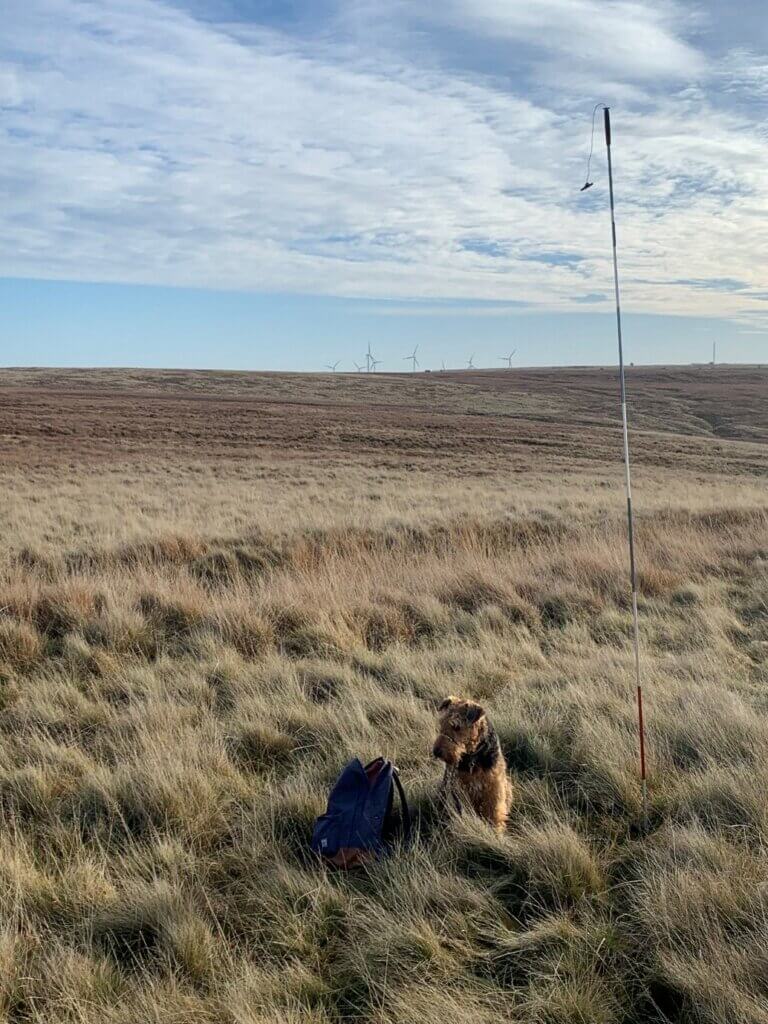
The lateral ditch just above the dog’s head runs across the top of the grazing and intercepts water coming off the peat. It acts like the conduit on the other side. There might once have been deep peat here too, but centuries of grass production, drainage and sheep have impoverished the ground, and the probe shows the peat is less than 10 cm deep. A direct route from here to the Cock Hill mast might seem to destroy little irreplaceable habitat. However this quiet area of longish grass is one of the best nesting sites on CWF, and another sign of irreplaceable habitat is the presence of red-listed birds: golden plover, curlew, and lapwing. The habitat is not just the peat, though the peat destruction in the full 302 MW CWF is so grotesque that one might lose focus, which may have been the point of the application in the first place.
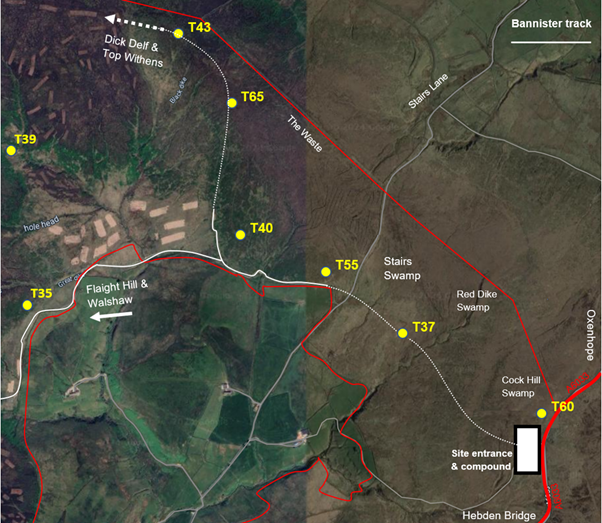
The map above shows this direct route to T37 Stairs Edge. The continuation to the rest of this illegal 170 MW wind farm is by the line of the Bannister shooting track which is not shown on the OS base maps used by Natural Power, but is very clear on Google maps. The shooting track would have to be doubled in width and greatly strengthened, but among the planning imperatives when laying out a wind farm network is to use the existing tracks and avoid the destruction of peat. Note that the Bannister track goes outside the CWF boundary for a short distance below the burned strips. The OS base map used by Natural Power does not have the shooting track on it. There is a poor track north towards T65 and this would open access to the grotesque 302 MW version. The continuation to Walshaw Dean and a potential illegal 170 MW wind farm will be discussed in a later blog, but the engineering crux of the route is at the point where the track crosses the CWF boundary at the bridge over Mare’s Greave Clough, shown on the detail below. The clough sides are steep here and a serious bridge will have to be built to reduce the gradient.
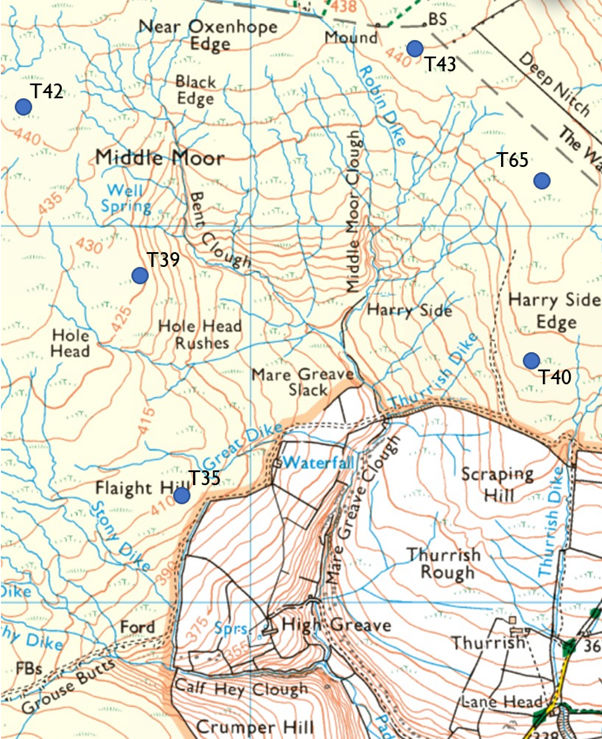
Back at T37 Stairs Edge, the peat survey shows the inevitability of the route from the entrance compound to T37 Stairs Edge.
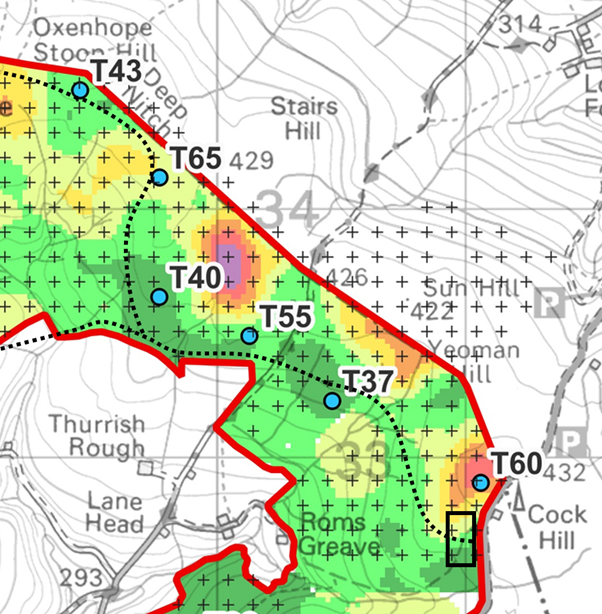
Since the road system should be on the least deep peat, it would be absurd for the planners to allow T60 Cock Hill Swamp, which is the only turbine in CWF layout scheduled for red-depth 2.5-3 metres peat. T60 will go on Yeoman Hill and the compound as far south as possible while remaining fairly flat.
The entrance compound is shown at two hectares. At various times this compound must host a pile of imported limestone aggregate to build the tracks, since the onsite rock is too weak and porous for roadstone, especially above the snow line. Later the compound will have a concrete batching plant, using more limestone, since the onsite rock is too weak to make concrete too, except for garden gnomes. Later still it will be a laying down area for turbine blades and pylon sections so that turbine erection can proceed somewhat independently of the delivery convoys. At completion, this compound must be restored. It is two hectares of metre deep alien limestone on an irreplaceable habitat so the restoration can only be cosmetic.
We must remember that no wind farm of any size can be built on Walshaw Moor without new law being passed to weaken the habitat regulations that apply to Special Areas of Conservation (the blanket bog on Walshaw Moor) and Special Protection Areas (the merlins and golden plovers and breeding assemblages of curlews and lapwings). This law is integrated with European Law (CWF is on a Natura 2000 site). Reneging on the habitat regulations has been made much more embarrassing for our government because at COP 15 in 2022 we signed the Kunming-Montreal Global Biodiversity Framework. England is counting on deeply protected blanket bog to get us up to the 30% threshold specified in the framework. If the habitat regulations are slackened to permit the destruction of blanket bog by wind farms then we are sending our delegates, as Aneurin Bevan said about the atom bomb, “naked into the conference chamber”.
We like to think we lead the world in conservation. David Attenborough is the only person we could all stand as elected Head of State. (In a poll, other candidates, in order of popularity, were “Me”, Stephen Fry, Chris Packham, Joanna Lumley and Jeremy Clarkson.)
What did degraded Britain bring to the Kunming-Montreal table as irreplaceable habitat? “We see your Amazon rainforest and the Okavango Delta and raise you Spurn Head Spit?” The biggest area we scheduled was unglamorous blanket bog (50 cm and deeper) and this was what Defra said about it in October 2023.
“The irreplaceable habitats list recognises and protects England’s most valuable habitats. They have a high biodiversity value and are so difficult to recreate, that it would be impossible to achieve the requirement to increase biodiversity on top of no net loss.
Irreplaceable habitats have significant protection in the National Planning Policy Framework. Impacts on these habitats from development require a strong justification. BNG (Biodiversity Net Gain) will strengthen these protections further.
For BNG purposes, the 10% net gain requirement is not applied to irreplaceable habitats, as they are so valuable, they cannot be easily recreated.”
The schedule of irreplaceable habitats is published in the Biodiversity Gain Requirements (Irreplaceable Habitat) Regulations 2024.
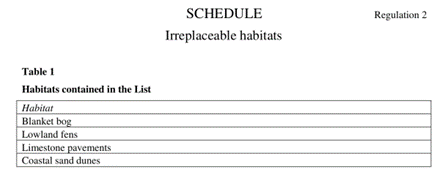
The illegal track from Cock Hill Swamp to Stairs Edge already destroys an irreplaceable habitat, and we haven’t even got to the 1.5-2 metre peat on Flaight Hill or Oxenhope Edge. But in the draft National Planning Policy Framework recently put out to consultation, there is a weasel footnote, and it is on this that Christopher Wilson’s £12 million venture capital bet hangs. They want to put a wind farm on legally protected irreplaceable habitat that is part of an international agreement and …
186.c Development resulting in the loss or deterioration of irreplaceable habitats (such as ancient woodland and ancient or veteran trees) should be refused, unless there are wholly exceptional reasons68 and a suitable compensation strategy exists.
68 For example, infrastructure projects (including nationally significant infrastructure projects, orders under the Transport and Works Act and hybrid bills), where the public benefit would clearly outweigh the loss or deterioration of habitat.
Nobody knows how to compensate for the loss of the irreplaceable and the planning laws don’t pretend that it is possible using developer tricks to improve biodiversity scores by 10%. CWF is on irreplaceable habitat and wholly within an SPA and SAC. It is triply protected. Footnote 68 relates to the newer idea of “irreplaceable habitats” which are more widespread than the SAC and SPA network. Invoking footnote 68 does not remove the deeper protections of the Habitat Regulations for an SPA or SAC.
It is very instructive to look at the Habitat Regulations Assessment made by DESNZ accompanying the letter in which Ed Miliband overruled the Planning Inspectorate’s rejection of the Sunnica 50MW solar farm outside Newmarket on 12 July 2024, just a week after the General Election result.

The site is close to the SPA (stone curlew) and SAC (Breckland) but it is not inside it, and a 2 km buffer is shown around the site. This decision really doesn’t give Christopher Wilson much comfort, in fact the reverse. The implacability of the regulations on SPA and SAC and the importance of buffering are clearly set out in the HRA. The Miliband letter, just a week into power, shows his determination to push on hard with renewables, but the legal abyss between Sunnica 2 km outside an SAC/SPA and 170 MW CWF wholly inside the SPA/SAC (let alone the absurd 302 MW CWF of the scoping report) is unbridgeable. The Sunnica decision shows that the Planning Inspectorate will definitely reject any wind farm on the irreplaceable habitats of the Walshaw Moor SAC/SPA, exactly as Calderdale would have done, and on the same national and international legal grounds, and the rejection will be fierce. I don’t think DESNZ will overrule but if they did the conservation roof would fall in.
The only thing that might give anyone pause is Christopher Wilson’s expenditure of £12 million on the off chance. But Christopher “440 Kelvin-Volts” Wilson has no relevant track record in this kind of investment. He allowed his website to perpetrate absolute rubbish about where CWF was accepted to connect and the voltage of the National Grid, couldn’t get his consultants to finish the peat survey, and didn’t think to ask the gamekeepers why the tracks are grey. He will have a go in the Spring if his backer Dr Osman can stand the heat.
Marcus Trinick KC who has appeared as advocate at more than a hundred wind farm public inquiries across the UK, says that if the minister is ruled to have fallen foul of the habitats regulations, “They can’t just plead climate change and all the other arguments in favour of renewables. Your project is almost certainly dead as proving an overriding public interest and that there is no alternative solution to the development is an immense uphill struggle. We all admire Ed Miliband’s commitment to renewables and support the brave steps he is taking. However, it is one thing for a minister to take a view on subjective matters of policy or opinion, such as landscape and visual impacts, but quite another to overrule a planning inspector on the Habitats Regulations.”
In these recent blogs I have been writing about this shy, illegal, 170 MW version of CWF because I think we must be ready for Christopher Wilson’s attempt to exploit Footnote 68 should he make a planning application in Spring 2025. When we next upbraid the Japanese for whaling or the US for drilling in the Arctic, do we really want them to remind us that in our greed for electricity, we couldn’t even keep our mitts off the deeply protected irreplaceable habitats on Walshaw Moor?
++++++++++++++++++++++++++++++++++++++++++++++++++++++++++
Bog
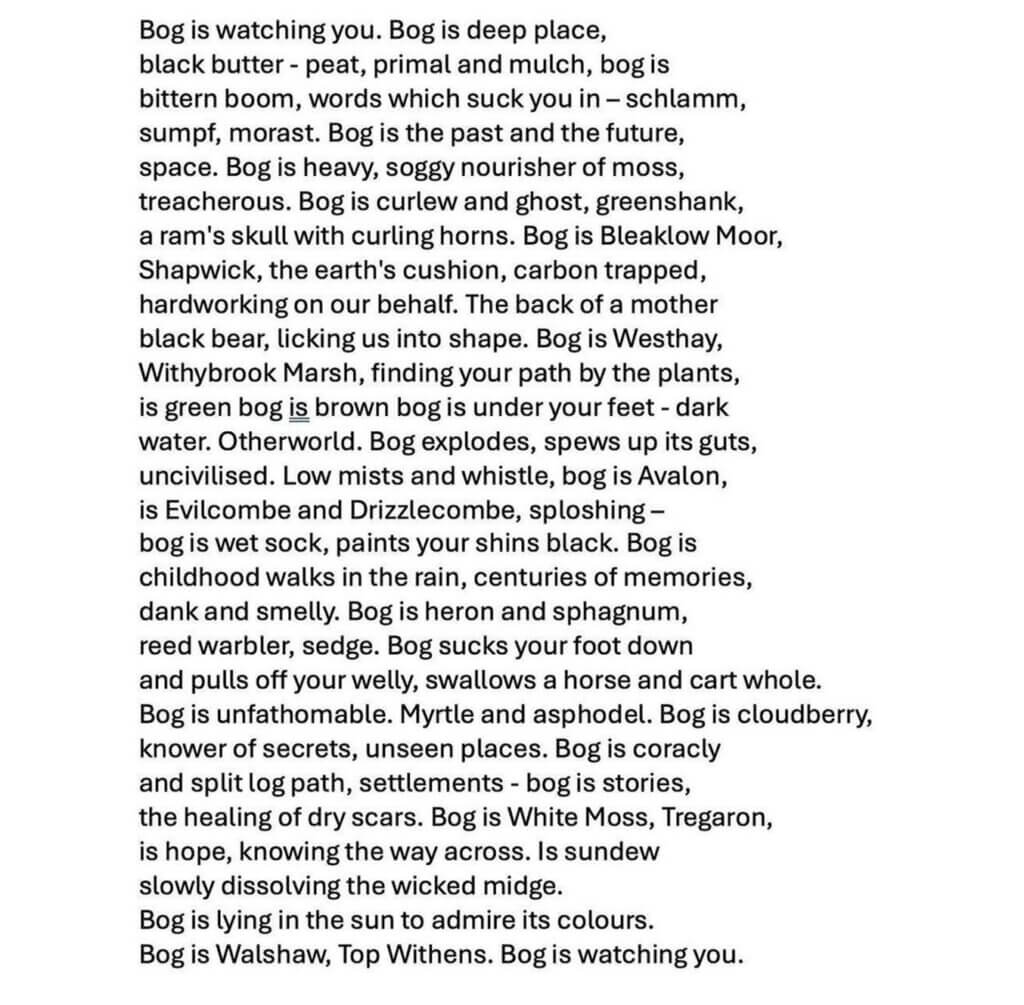
++++++++++++++++++++++++++++++++++++++
This is the 26th in a series of 65 guest blogs on each of the wind turbines which Richard Bannister plans to have erected on Walshaw Moor. Turbines 5, 6, 8, 9, 11, 17, 21, 25, 27, 32, 33, 34, 35, 37, 40, 43, 44, 47, 54, 56, 58, 62, 64 and 65 have already been described. To see all the blogs – click here.
[registration_form]